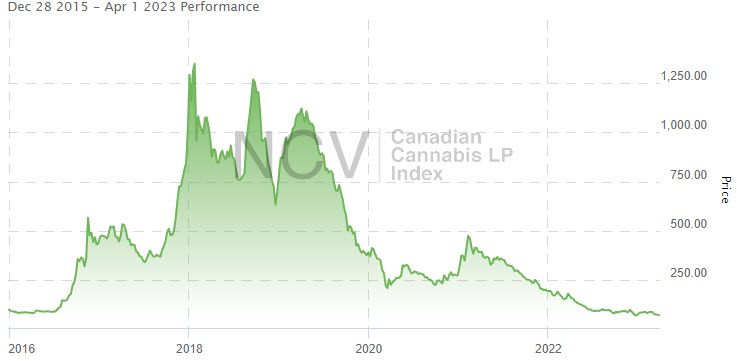As we described in a previous article, the Global Cannabis Stock Index fell in February after rising to begin the year. In March, the index plunged 15.2%, leaving it down 12.5% in the first quarter of the year. This follows a record decline of 70.4% for 2022.
In this exclusive article we will summarize the performance of the other managed indices that New Cannabis Ventures offers to its readers. We will discuss the performance of the American Cannabis Operator Index, Ancillary Cannabis Index and Canadian Cannabis LP Index as well as Canadian Cannabis LP index Tier 1, 2 and 3.
American Cannabis Stocks Index
The American Cannabis Operator Index was one of the weakest parts of the market in January, but it was relatively strong in February when it was unchanged from January. In March, the index plunged 14.0% to 13.02, leaving it down 8.6% in 2023:
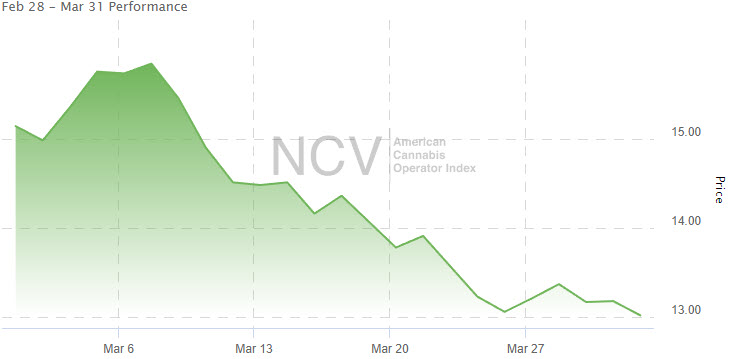
Down 22.9% in Q4 after a collapse in December, it was down 65.8% in 2022 to 14.25, slightly ahead of the Global Cannabis Stock Index. Over the past year, the index has declined 66.6%:
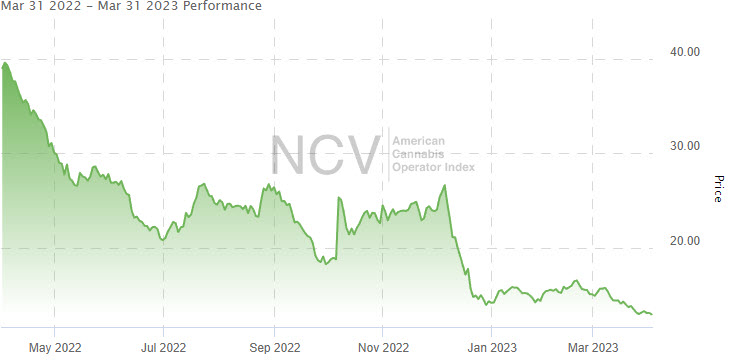
The index, which launched in October 2018, finally took out the low from March 2020 in late 2022 and extended the decline in March:
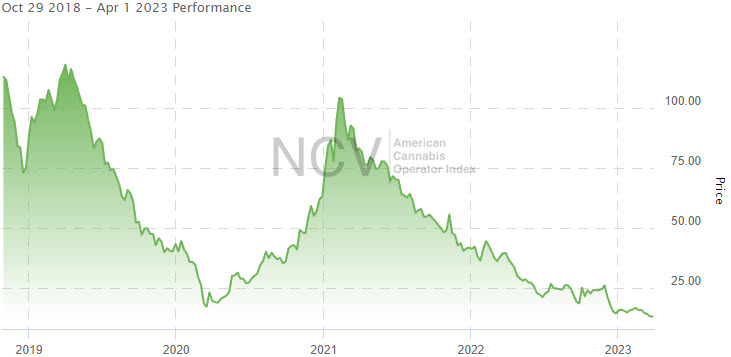
During March, the two best stocks were down just a little, while the worst stocks fell sharply. Verano Holdings (OTC: VRNOF) (CSE: VRNO) fell just 1.4%. The February winner, TerrAscend (OTC: TRSSF) (CSE: TER) fell just 3.1% in March. Ayr Wellness (OTC: AYRWF) CSE: AYR.A), the worst performer in February, was down 42.5% in March.
In April, the index will remain at 11 members with the deletion of Jushi Holdings (OTC: JUSHF) (CSE: JUSH) and the return of Planet 13 Holdings (OTC: PLNHF) (CSE: PLTH).
Ancillary Cannabis Index
The Ancillary Cannabis Index plunged 16.1% to 13.79, down 8.2% in 2023:
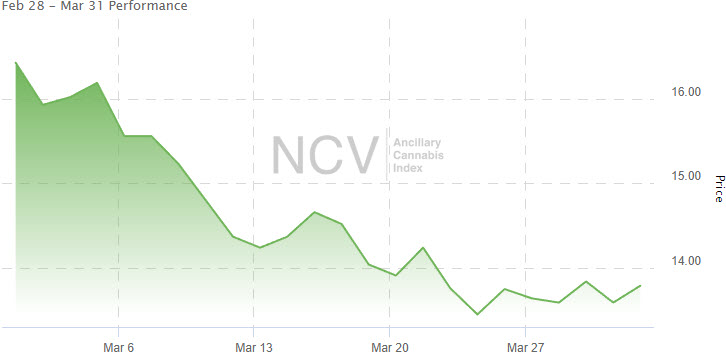
The index, with a massive loss of 76.6% in 2022 to 15.02, has declined 73.9% over the past year:
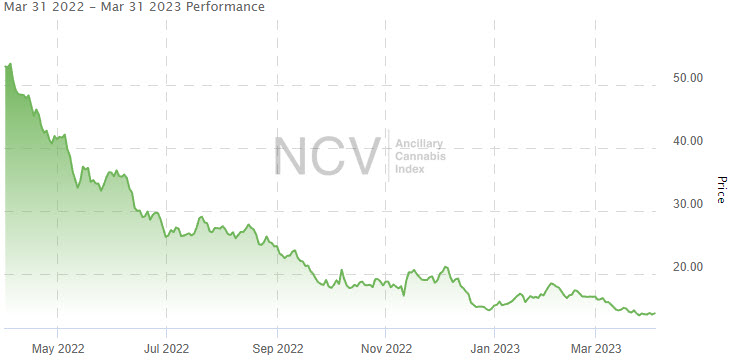
The index is down over 86% since launching at the end of March in 2021:
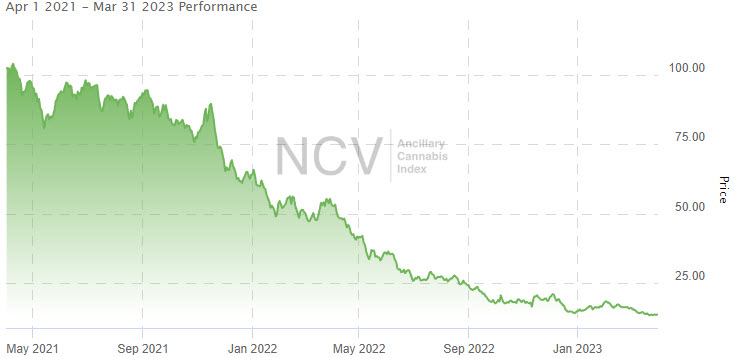
The best performer in March was Chicago Atlantic (REFI), down 7.8%, and the worst performing stock was AFC Gamma (NASDAQ: AFCG).
In April, the index will increase to 9 members with the return of WM Technology (NASDAQ: MAPS).
Canadian Cannabis LP Index
The Canadian Cannabis LP Index was very strong to begin the year, rising 19.4% in January and falling just slightly in February, but the index plunged 15.4% in March to 72.65:
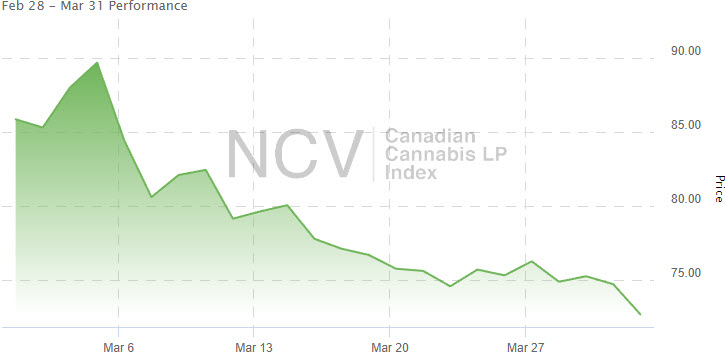
The index, down 11.4% in Q4 , declined 62.8% in 2022 to 72.59. It is up 0.1% so far in 2023. Over the last year, it has dropped by 57.1%.
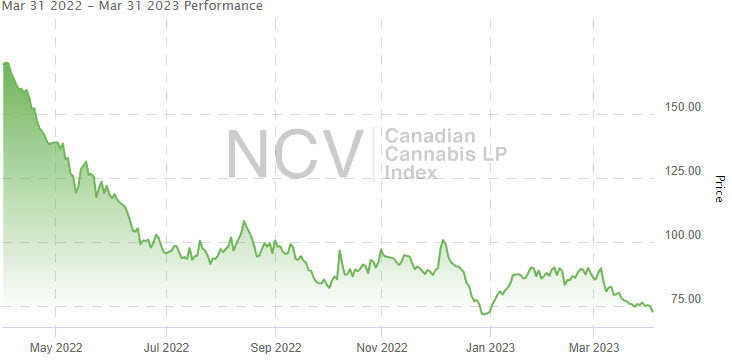
The index, which made a new all-time low in December, is down a lot from its peak:
Canadian Cannabis LP Tier 1 Index
During January, Tier 1 surged 23.9%, and it fell 10% in February. In March, it dropped 19.4% to 79.21. Tier 1 was down 72.0% in 2022, ending at 88.14, and it is down 10.1% in 2023. Among Tier 1 companies, Tilray Brands (TSX: TLRY) (NASDAQ: TLRY) was the best performer, falling 10.9% during the month. The worst Tier 1 stock in March was Canopy Growth (TSX: WEED) (NASDAQ: CGC) again, falling 25.2%. Note that HEXO Corp. (TSX: HEXO) (NASDAQ: HEXO) moved at the end of March from Tier 1 to Tier 2 due to its sharply lower revenue.
Canadian Cannabis LP Tier 2 Index
Tier 2 index gained 7.5% in January, and it dropped 7.4% in February. In March it fell 8.1% to 100.49. In 2022, it lost 58.9%, closing at 109.79, and it is down 8.5% in 2023.
Canadian Cannabis LP Tier 3 Index
Tier 3 index rose 26.1% in January, and it gained 8.0% in February. In March, it plunged 18.9% to 19.50. It ended at 17.66 in 2022, declining 62.8% for the year, and it has gained 10.4% so far in 2023.
New Cannabis Ventures maintains seven proprietary indices designed to help investors monitor the publicly-traded cannabis stocks, including the Global Cannabis Stock Index as well as the Canadian Cannabis LP Index and its three sub-indices. The sixth index, the American Cannabis Operator Index, was launched at the end of October 2018 and tracks the leading cultivators, processors and retailers of cannabis in the United States. Afterwards, we introduced the Ancillary Cannabis Index at the end of March 2021, reflecting the increasing number of publicly-traded companies providing goods or services to cannabis operators.

